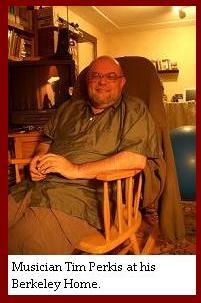 Old Friend, New Friend
Old Friend, New FriendMy Columbia buddy Rick Streicker was in town. We kicked off our somewhat businessy tour of Silicon Valley--and a daylong conversation about the future of media--appropriately enough. We stopped in at the San Francisco studios of the newly launched Current.tv, where we got to chill with a local friend of mine, Current's (and Snarkmarket's) blogger Robin Sloan. We closed the day equally appropriately by hanging out with local friend of Rick's, musician and software engineer Tim Perkis.
Wow, where to start. The video editing equipment brought up the topic of a film Tim is working on about the local sound-art/electronic music scene, Noisy People. That in turn brought up the topic of his own music. Tim put together his own degree-program in Vidoe and Computer Art--back in 1974. He came out to the Bay Area to go to art school, and has a list of musical performances extending back to 1978 and including several countries. His groups include Hub, the League of Automatic Music Composers, Rotodoti, the Natto Quartet, Fuzzybunny and All Tomorrow's Zombies.
I'll be frank and say I don't know a whole lot about sound-art, super modern electronic music, or edgy jazz and composition. I've got some John Zorn, some mildly abstract Joshua Redman, some trance, the Pi soundtrack, and that's about it. But it's been coming up socially fairly often, and things like surfing the hyperreal music archive, as well as the very recent death of Robert Moog have been making me want to check out this kind of stuff more and more.
Tim was kind enough to give me a couple of his CDs. I'm now listening to Motive, from Praemedia (originally from Artifact). So far, it's rhythmic, creepy and affecting--textured patterns of sound that lope and jog and even gallop, all the more suggestive for often being difficult to recognize or place. It's music to ponder the future with, in bits and pieces.
I was particularly intrigued by reading about his past project Rasamudra, a performance system at the San Francisco Exploratorium in 1994. Rasa can mean mood or feeling in Sanskritic languages, and mudra can be meaningful hand gesture. It seems that Rasamudra teamed up two human performers and a sound-generating computer system. The computer generated sounds, to which the performers reacted--both by giving the computer reactive instructions and by communicating to each other with hand gestures, allowing the performers to also interact with each other. The classical Indian dance form I practice, Bharat Natyam, also uses mudras to communicate both meaning and pure design. (Indeed, illustrations of some of these mudras decorate the Rasamudra website.) Also, besides the traditional notion of music creating dance by inspiring and directing it, we have a strong notion of the dancer creating percussive music with his or her bell-bedecked, stomping feet. So I am just entranced by the notion of also creating music with my hand gestures. Goodness, if we had the ability to control harmonies with facial expressions and eye-movements, we could dance out entire abstract symphonies.
Amusingly enough, I hung out plenty at the Exploratorium around 1994. Tim doesn't live very far away from me, in a charming Berkeley neighbhorhood I've often examined from a Bart train zooming above, but never explored down below. It took Rick visiting from New York to find these things. So much to see right around town, like the dew drop on the stalk of rice two steps from the house.